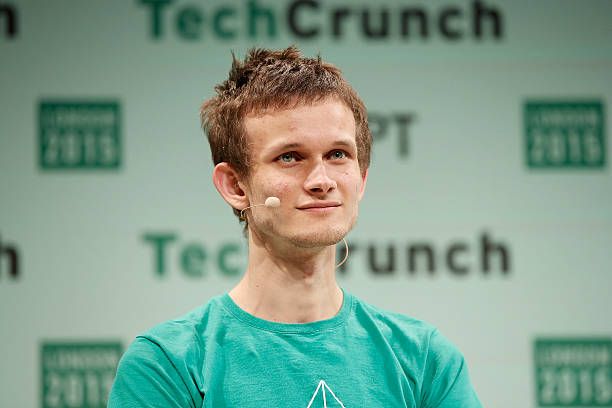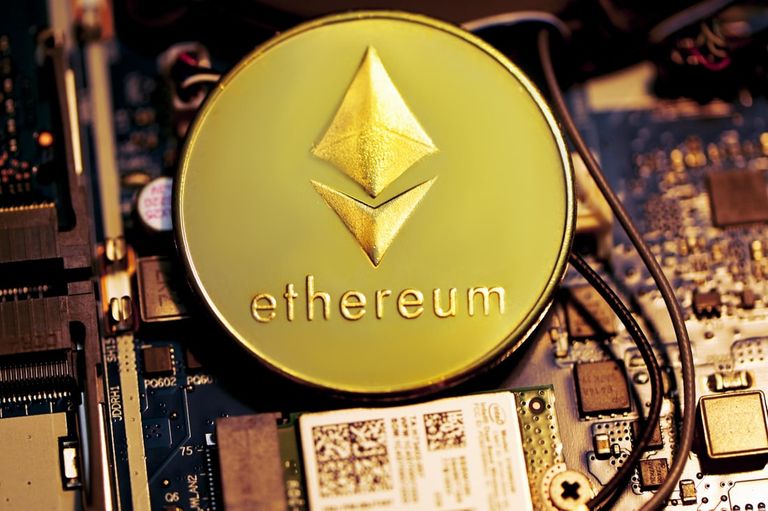Founding (2013–2014).

Ethereum co-founder Vitalik Buterin in 2015
Ethereum was initially described in late 2013 in a white paper by Vitalik Buterin, a programmer and co-founder of Bitcoin Magazine, that described a way to build decentralized applications. Buterin argued to the bitcoin core developers that Bitcoin and blockchain technology could benefit from other applications besides money and that it needed a more robust language for application development : 88 that could lead to attaching[clarification needed] real-world assets, such as stocks and property, to the blockchain. In 2013, Buterin briefly worked with eToro CEO Yoni Assia on the Colored Coins project and drafted its white paper outlining additional use cases for blockchain technology. However, after failing to gain agreement on how the project should proceed, he proposed the development of a new platform with a more robust scripting language—a Turing-complete programming language—that would eventually become Ethereum.
Ethereum was announced at the North American Bitcoin Conference in Miami, in January 2014. During the conference, Gavin Wood, Charles Hoskinson, and Anthony Di Iorio (who financed the project) rented a house in Miami with Buterin at which they could develop a fuller sense of what Ethereum might become. Di Iorio invited friend Joseph Lubin, who invited reporter Morgen Peck, to bear witness. Peck subsequently wrote about the experience in Wired.[20] months later the founders met again in Zug, Switzerland, where Buterin told the founders that the project would proceed as a non-profit. Hoskinson left the project at that time and soon after founded IOHK, a blockchain company responsible for Cardano.
Ethereum has an unusually long list of founders. Anthony Di Iorio wrote: "Ethereum was founded by Vitalik Buterin, Myself, Charles Hoskinson, Mihai Alisie & Amir Chetrit (the initial 5) in December 2013. Joseph Lubin, Gavin Wood, & Jeffrey Wilcke were added in early 2014 as founders." Buterin chose the name Ethereum after browsing a list of elements from science fiction on Wikipedia. He stated, "I immediately realized that I liked it better than all of the other alternatives that I had seen; I suppose it was the fact that [it] sounded nice and it had the word 'ether', referring to the hypothetical invisible medium that permeates the universe and allows light to travel." Buterin wanted his platform to be the underlying and imperceptible medium for the applications running on top of it.
Development (2014)
Formal development of the software underlying Ethereum began in early 2014 through a Swiss company, Ethereum Switzerland GmbH (EthSuisse). The idea of putting executable smart contracts in the blockchain needed to be specified before the software could be implemented. This work was done by Gavin Wood, then the chief technology officer, in the Ethereum Yellow Paper that specified the Ethereum Virtual Machine. Subsequently, a Swiss non-profit foundation, the Ethereum Foundation (Stiftung Ethereum), was founded. Development was funded by an online public crowd sale from July to August 2014, in which participants bought the Ethereum value token (Ether) with another digital currency, Bitcoin. While there was early praise for the technical innovations of Ethereum, questions were also raised about its security and scalability.
Launch and the DAO event (2014–2016)
Ethereum protocol upgrades
Code name
Release date
Release block
Frontier
30 July 2015
0
Ice Age
8 September 2015
200,000
Homestead
15 March 2016
1,150,000
DAO Fork
20 July 2016
1,920,000
Tangerine Whistle
18 October 2016
2,463,000
Spurious Dragon
23 November 2016
2,675,000
Byzantium
16 October 2017
4,370,000
Constantinople
28 February 2019
7,280,000
St. Petersburg
28 February 2019
7,280,000
Istanbul
8 December 2019
9,069,000
Muir Glacier
2 January 2020
9,200,000
Berlin
15 April 2021
12,244,000
London
5 August 2021
12,965,000
Several codenamed prototypes of Ethereum were developed over 18 months in 2014 and 2015 by the Ethereum Foundation as part of their proof-of-concept series. "Olympic" was the last prototype and public beta pre-release. The Olympic network gave users a bug bounty of 25,000 Ether for stress-testing the Ethereum blockchain. In July 2015, "Frontier" marked the official launch of the Ethereum platform, and Ethereum created its "genesis block."
Since the initial launch, Ethereum has undergone several planned protocol upgrades, which are important changes affecting the underlying functionality and/or incentive structures of the platform. Protocol upgrades are accomplished by means of a hard fork.
In 2016, a decentralized autonomous organization called The DAO—a set of smart contracts developed on the platform—raised a record US$150 million in a crowd sale to fund the project.The DAO was exploited in June 2016 when US$50 million of DAO tokens were stolen by an unknown hacker. The event sparked a debate in the crypto-community about whether Ethereum should perform a contentious "hard fork" to reappropriate the affected funds. This resulted in the network splitting into two blockchains: Ethereum with the theft reversed and Ethereum Classic which continued on the original chain. The hard fork created a rivalry between the two networks. After the hard fork, Ethereum subsequently forked twice in the fourth quarter of 2016 to deal with other attacks.
Continued development and milestones (2017–present)
In March 2017, various blockchain startups, research groups, and Fortune 500 companies announced the creation of the Enterprise Ethereum Alliance (EEA) with 30 founding members. By May 2017, the nonprofit organization had 116 enterprise members, including ConsenSys, CME Group, Cornell University's research group, Toyota Research Institute, Samsung SDS, Microsoft, Intel, J. P. Morgan, Cooley LLP, Merck KGaA, DTCC, Deloitte, Accenture, Banco Santander, BNY Mellon, ING, and National Bank of Canada.By July 2017, there were over 150 members in the alliance, including MasterCard, Cisco Systems, Sberbank, and Scotiabank.
In January 2018, Ethereum was the second-largest cryptocurrency in terms of market capitalization, behind Bitcoin. As of 2021, it maintained that relative position.
After the Constantinople upgrade on 28 February 2019, there were two network upgrades made within a month late in the year: Istanbul on 8 December 2019 and Muir Glacier on 2 January 2020.
In 2019, Ethereum Foundation employee Virgil Griffith was arrested by the US government for presenting at a blockchain conference in North Korea. He would later plead guilty to the charges[clarification needed] in 2021.
In March 2021, Visa Inc. announced that it began settling stablecoin transactions using Ethereum. In April 2021, JP Morgan Chase, UBS, and MasterCard announced that they were investing US$65 million into ConsenSys, a software development firm that builds Ethereum-related infrastructure.
There were two network upgrades in 2021. The first was "Berlin", implemented on 14 April 2021. The second was "London", which took effect on 5 August. The London upgrade included Ethereum Improvement Proposal ("EIP") 1559, a mechanism for reducing transaction fee volatility. The mechanism causes a portion of the Ether paid in transaction fees for each block to be destroyed rather than given to the miner, reducing the inflation rate of Ether and potentially resulting in periods of deflation.
On 27 August 2021, the blockchain experienced a brief fork that was the result of clients running different incompatible software versions.

Ethereum 2.0
Ethereum 2.0 releases
Code name
Release date
Release block
ETH 2.0 Phase 0 (Beacon Chain)
1 December 2020
0
ETH 2.0 Phase 1 (planned)
~Q3 2022
TBD
ETH 2.0 Phase 2 (planned)
~2023
TBD
Open-source development is currently[may be outdated as of March 2022] underway for a major upgrade to Ethereum known as Ethereum 2.0 or Eth2.
The main purpose of the upgrade is to increase transaction throughput for the network from the current rate of about 15 transactions per second[citation needed] to, theoretically, up to tens of thousands of transactions per second.This is to be accomplished by splitting up the workload into many blockchains running in parallel (referred to as "sharding") and then having them all share a common consensus proof-of-stake blockchain, so that to maliciously tamper with any singular chain would require one to tamper with the common consensus, which would cost the attacker far more than they could gain from an attack.
Ethereum’s Proof of Stake blockchain, has raised centralization worries in relation to Ethereum’s long-term health and security.
Ethereum 2.0 (also known as Serenity) is designed to be launched in three phases:[citation needed]
"Phase 0" (or "Beacon Chain") was launched on 1 December 2020 and created the Beacon Chain, a proof-of-stake (PoS) blockchain that will act as the central coordination and consensus hub of Ethereum 2.0.
"Phase 1" (or "The Merge") will merge the Beacon Chain with the current Ethereum network, transitioning its consensus mechanism from proof-of-work to proof-of-stake. As of 26 January 2022, it is expected to be released in the third quarter of 2022.
"Phase 2" (or "Shard chains") will implement state execution in the shard chains with the current Ethereum 1.0 chain expected to become one of the shards of Ethereum 2.0. Shard chains will spread the network's load across 64 new chains. As of 22 January 2022, it is expected to be released in 2023.
Do vote @Blurt.Live as your Witness
Posted from https://blurt.live